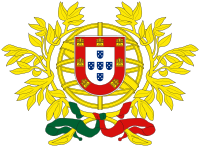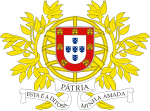Coat of arms of Portuguese Empire
| Coat of arms of Portugal | |
|---|---|
 |
|
| Versions | |

Lesser arms, used on the national flag and governmental flags of the Republic
|
|

Coat of arms used in the military colors
|
|
| Details | |
| Armiger | Portuguese Republic |
| Adopted | 30 June 1911 |
| Escutcheon | Argent, five escutcheons in cross azure each charged with as many plates in saltire, all within a bordure gules charged with seven golden triple-towered castles |
| Other elements | Behind the shield, an armillary sphere between two olive branches embowed Or bound together in base by a ribbon vert and gules. |
The coat of arms of Portugal is the main heraldic insignia of Portugal. The present model was officially adopted on 30 June 1911, along with the present model of the Flag of Portugal. It is based on the coat of arms used by the Portuguese Kingdom since the Middle Ages. The coat of arms of Portugal is popularly referred as the Five Quinas or simply the Quinas (quinas being the Portuguese term for quincunxes).
The Portuguese coat of arms is the result of almost a millennium of modifications and alterations. Starting with Count Henry, blue cross on a silver shield, successive elements were added or taken, culminating with the complex heraldic design that was officially adopted in 1911 (after the Republican Revolution of 1910). The two stripes bear the colours of the Portuguese flag: red and green.
After the official recognition of the Kingdom of Portugal as an independent country in 1143 (it had been self declared as so in 1139), silver bezants were added to the blue cross of the shield, symbolising coins and the right of the monarch to issue currency, as leader of a sovereign state. Eventually, and given the enormous dynamism of medieval heraldry, it is believed that the shield degraded and lost some elements in battle, eventually losing the cross format. This is how King Sancho I inherited the shield from his father, Afonso Henriques, with the cross replaced by escutcheons with the silver bezants. A traditional legend explains that these escutcheons represent the five moor kings defeated by King Afonso I of Portugal in the battle of Ourique.
...
Wikipedia
